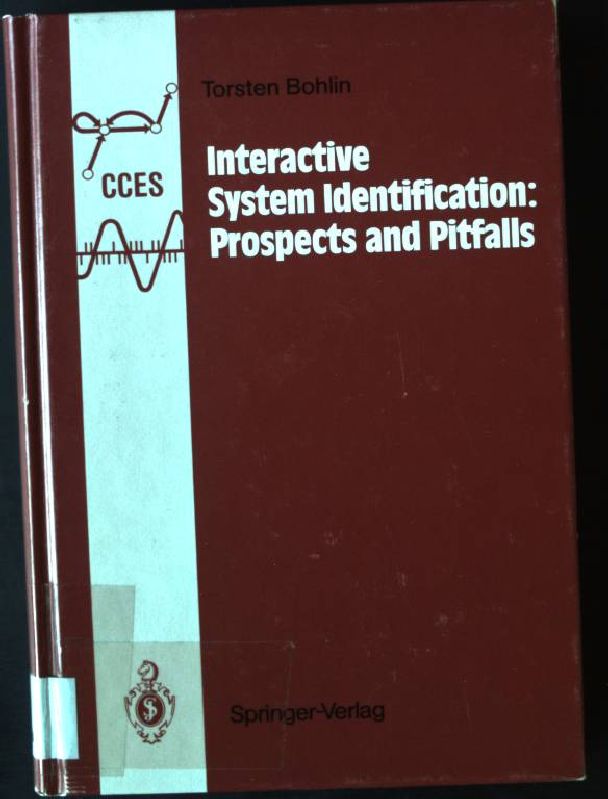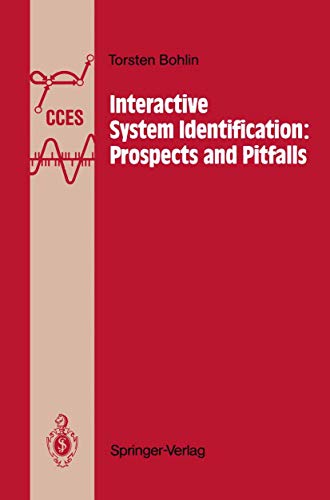
Interactive system identification : prospects and pitfalls. Communications and control engineering series - used book
1991, ISBN: 3540536361
[EAN: 9783540536369], Gebraucht, sehr guter Zustand, [SC: 2.2], [PU: Springer Verlag;], SYSTEMIDENTIFIKATION, INFORMATIK, DATENVERARBEITUNG, TECHNIK ALLGEMEIN, XII, 365 Seiten; Das hier a… More...
| ZVAB.com Petra Gros, Koblenz, Germany [1048006] [Rating: 5 (von 5)] NOT NEW BOOK. Shipping costs: EUR 2.20 Details... |

Interactive system identification : prospects and pitfalls. Communications and control engineering series - used book
1991, ISBN: 3540536361
[EAN: 9783540536369], Gebraucht, sehr guter Zustand, [PU: Springer Verlag;], SYSTEMIDENTIFIKATION, INFORMATIK, DATENVERARBEITUNG, TECHNIK ALLGEMEIN, XII, 365 Seiten; Das hier angebotene B… More...
| AbeBooks.de Petra Gros, Koblenz, Germany [1048006] [Rating: 5 (von 5)] NOT NEW BOOK. Shipping costs: EUR 2.20 Details... |

Interactive system identification : prospects and pitfalls. Communications and control engineering series - hardcover
1991, ISBN: 9783540536369
XII, 365 Seiten; gebundene Ausgabe Das hier angebotene Buch stammt aus einer teilaufgelösten wissenschaftlichen Bibliothek und trägt die entsprechenden Kennzeichnungen (Rückenschild, Ins… More...
| buchfreund.de |

ISBN: 9783540536369
Prospects and Pitfalls Livre - Livre, [PU: Springer, Berlin/Heidelberg]
| Fnac.com Nr. Shipping costs:, Le délai dépend du marchand, zzgl. Versandkosten. (EUR 8.30) Details... |

ISBN: 3540536361
[EAN: 9783540536369], Neubuch, [PU: Springer], Mathematics|Differential Equations, pp. 365
| AbeBooks.de Majestic Books, London, ,, United Kingdom [51749587] [Rating: 3 (von 5)] NEW BOOK Shipping costs: EUR 4.72 Details... |


Interactive system identification : prospects and pitfalls. Communications and control engineering series - used book
1991, ISBN: 3540536361
[EAN: 9783540536369], Gebraucht, sehr guter Zustand, [SC: 2.2], [PU: Springer Verlag;], SYSTEMIDENTIFIKATION, INFORMATIK, DATENVERARBEITUNG, TECHNIK ALLGEMEIN, XII, 365 Seiten; Das hier a… More...

Bohlin, Torsten (Verfasser):
Interactive system identification : prospects and pitfalls. Communications and control engineering series - used book1991, ISBN: 3540536361
[EAN: 9783540536369], Gebraucht, sehr guter Zustand, [PU: Springer Verlag;], SYSTEMIDENTIFIKATION, INFORMATIK, DATENVERARBEITUNG, TECHNIK ALLGEMEIN, XII, 365 Seiten; Das hier angebotene B… More...

Interactive system identification : prospects and pitfalls. Communications and control engineering series - hardcover
1991
ISBN: 9783540536369
XII, 365 Seiten; gebundene Ausgabe Das hier angebotene Buch stammt aus einer teilaufgelösten wissenschaftlichen Bibliothek und trägt die entsprechenden Kennzeichnungen (Rückenschild, Ins… More...
ISBN: 9783540536369
Prospects and Pitfalls Livre - Livre, [PU: Springer, Berlin/Heidelberg]
ISBN: 3540536361
[EAN: 9783540536369], Neubuch, [PU: Springer], Mathematics|Differential Equations, pp. 365
Bibliographic data of the best matching book
Details of the book - Interactive System Identification: Prospects and Pitfalls (Communications and Control Engineering)
EAN (ISBN-13): 9783540536369
ISBN (ISBN-10): 3540536361
Hardcover
Publishing year: 1991
Publisher: Springer-Verlag Berlin and Heidelberg GmbH & Co. K
Book in our database since 2008-04-22T13:04:52-04:00 (New York)
Detail page last modified on 2019-03-05T05:18:38-05:00 (New York)
ISBN/EAN: 3540536361
ISBN - alternate spelling:
3-540-53636-1, 978-3-540-53636-9
Alternate spelling and related search-keywords:
Book author: bohlin
Book title: system identification, control systems engineering, communications and control engineering
Information from Publisher
Author: Torsten Bohlin
Title: Communications and Control Engineering; Interactive System Identification: Prospects and Pitfalls
Publisher: Springer; Springer Berlin
365 Pages
Publishing year: 1991-04-15
Berlin; Heidelberg; DE
Printed / Made in
Weight: 0,700 kg
Language: English
85,55 € (DE)
87,95 € (AT)
106,60 CHF (CH)
Not available, publisher indicates OP
BB; Book; Hardcover, Softcover / Informatik, EDV/Anwendungs-Software; Computer-Aided Design (CAD); Verstehen; software; modeling; control engineering; Interaktives System; computer; system identification; Identifikation; Regelung; Identification; system; Interactive Systems; B; Computer-Aided Engineering (CAD, CAE) and Design; Engineering; Systems Theory, Control; Calculus of Variations and Optimal Control; Optimization; Mathematical and Computational Engineering; Engineering Design; Computer Hardware; Kybernetik und Systemtheorie; Variationsrechnung; Optimierung; Mathematik für Ingenieure; Konstruktion, Entwurf; Computerhardware; BC; EA
1: Introduction.- 1.1 The terminology.- 1.2 The software.- 1.3 The purpose.- 1.4 The experiment facilities.- 1.5 The model structure.- 1.6 The philosophy.- 2: Randomness, probability, and likelihood.- 2.1 Bayes’ idea.- 2.2 The information contents of an experiment.- 2.3 Covariation and causality.- 2.3.1 A theory for hidden variables.- 2.3.2 Probabilistic models.- 3: The experiment.- 3.1 An introductory example.- 3.2 Requirements for proper experimentation.- 3.2.1 Sufficient stimulation.- 3.2.2 Reproducibility.- 3.2.3 Separability.- 3.4 Dynamic systems.- 3.4.1 Large samples.- 3.5 Experiments on dynamic objects.- 3.5.1 Closed vs open loop.- 3.5.2 Cases of proper experiments.- 4: The identification problem.- 4.1 Validation and falsification.- 4.2 Model structures, data descriptions, and purposive models.- 4.3 Fitting.- 4.4 Basic identification procedures.- 4.4.1 Two general algorithms.- 4.5 Conditions for Bayesian validation.- 4.6 The origin of ‘pitfalls’.- 4.6.1 The consequences of unvalidatability.- 4.6.2 Purposive models without validation.- 4.6.3 Sources of information for model design.- 5: Modelling.- 5.1 Parametrization.- 5.1.1 Integer parameters.- 5.1.2 The parameter distribution.- 5.2 The parameter map.- 5.3 Algorithmic models.- 5.4 The modelling of dynamic systems.- 5.4.1 Linear vs nonlinear models.- 5.5 Internal and external models.- 5.5.1 External models.- 5.5.2 Innovations.- 5.5.3 Internal models.- 5.5.4 Discrete-time vs continuous-time models.- 5.6 Implicit and explicit models.- 5.7 Finite-memory models.- 5.7.1 Internal stale-vector models.- 5.8 Classification of models by purpose.- 5.9 ‘Black-box’ and ‘grey-box’ models.- 5.9.1 The requirements of the control purpose.- 5.9.2 The ‘black-box’ approach.- 5.9.3 The approach of separating disturbances.- 5.9.4 The ‘grey-box’ approach.- 6: Large-sample theory.- 6.1 Equivalent dynamic models.- 6.2 Consistency.- 6.2.1 The structured approach.- 6.2.2 The unstructured approach.- 6.3 Identifiability.- 6.4 Falsification in the limit.- 6.5 Proper ‘black-box’ identification.- 6.6 A concluding example.- 7: Validation techniques.- 7.1 Validating parametric models.- 7.2 Large-sample techniques.- 7.2.1 Approximations.- 7.2.2 Validating sufficient accuracy.- 7.3 Two ‘pitfalls’.- 8: Falsification techniques.- 8.1 Statistical tests.- 8.2 Unconditional falsification.- 8.2.1 Testing the parameter-free statistics.- 8.3 Conditional falsification of models.- 8.3.1 Asymptotic confidence regions.- 8.4 Conditional falsification of structures.- 8.5 The Likelihood-Ratio test.- 8.6 Efficiency vs safety.- 9: Structure identification.- 9.1 Using the biassed Likelihood.- 9.2 Sequential falsification.- 9.2.1 Sequence of conditional tests.- 9.2.2 Sequence of Likelihood-Ratio tests.- 9.2.3 Sequence of unconditional tests.- 9.3 Philosophy revisited: Equivalence vs goodness.- 9.4 Designing the criterion: Description vs purpose.- 9.5 Defining the optimal order: Accuracy vs complexity.- 9.5.1 Approximating the expected loss.- 9.5.2 Other ‘modern’ principles for determining complexity.- 9.5.3 The Bayesian approach.- 9.6 Model structure selection.- 9.7 Terminology revisited.- 10: A unified design procedure.- 10.1 Summary of conditions for proper identification.- 10.2 Identification procedures.- 10.3 Procedure for modelling and identification.- References.- Glossary of notations.This book analyses the fundamental problems and possibilities of designing purposive mathematical models of dynamical physical objects, including a number of 'pitfalls'. It states conditions for correct identification and suggests rules and procedures for making meaningful use of any identification software.
More/other books that might be very similar to this book
Latest similar book:
9783642486180 Interactive System Identification: Prospects and Pitfalls (Torsten Bohlin)
- 9783642486180 Interactive System Identification: Prospects and Pitfalls (Torsten Bohlin)
- 9783642486203 Interactive System Identification: Prospects and Pitfalls (Bohlin, Torsten)
- 9780387536361 Interactive System Identification: Prospects and Pitfalls (COMMUNICATIONS AND CONTROL ENGINEERING) (Torsten Bohlin)
< to archive...

